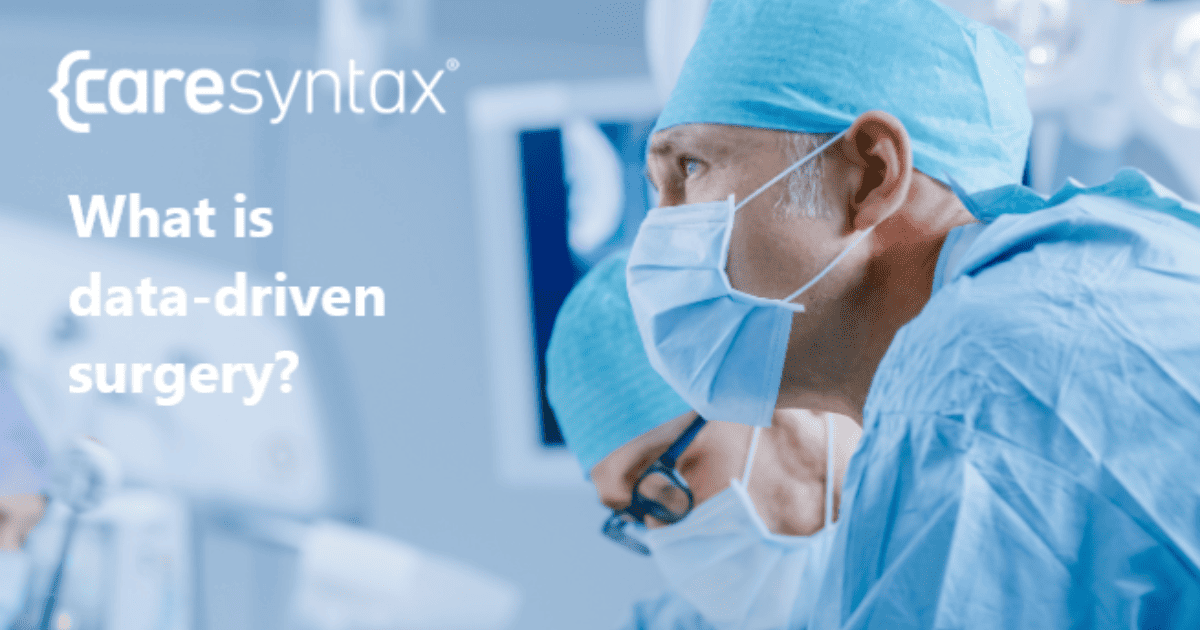
Article
Digital Commerce 360: Healthcare in the Cloud is Good and Necessary
Read More

Caresyntax Article
February 2, 2023
The use of artificial intelligence (AI) throughout the continuum of surgical care is growing, but widespread development and adoption presents some challenges. I joined moderator Brian Chapman of ZS Associates and a panel of surgical industry experts including Tom Calef, Activsurgical and Oliver Keown, MD Intuitive Ventures, to talk about those challenges and how AI and machine learning present opportunities for data-driven surgery.
Data-driven surgery is broader than digital surgery. Digital surgery is traditionally used by robotic vendors and med tech vendors to describe their proprietary ecosystem. Digital surgery needs to expand beyond robotics to data-driven surgery, which helps quantify proficiency, efficiency, patient outcomes, and financial outcomes. We need to ensure a system that examines all of those things before we start seeing value.
“Digital surgery needs to expand beyond robotics to data-driven surgery, which helps quantify proficiency, efficiency, patient outcomes, and financial outcomes.”
There is so much surgical data and information that is being created right now, from preoperative data and intraoperative data to post-operative data. The question is: what can surgeons do with all this data?
We help surgeons identify patient-specific, case-specific, operational-specific variation, and leverage data-driven surgery to help them remove that unnecessary variation. It is about reducing unnecessary variation and improving surgical outcomes on the clinical, operational, and financial side by applying AI, automation, and analytics.
We help create a High-Fidelity Surgical RecordTM that is a combination of everything that you can get from a pre-op, interop, and a post-op standpoint: information from imaging, electronic health records, and PACS systems. Intraoperatively, we bring in surgical video from the lap camera, device navigation, and anesthesia monitors, and post-operative information–length of stay, readmission, and other factors–to create that High-Fidelity Surgical Record. Then you apply the objective and subjective preferences that surgeons have, and you help them reduce variability. That improves patient outcomes, it improves operational efficiency, profitability, and reduces costs.
Proficiency – One of our key academic centers in France leveraged our system for resident and fellow training in MIPO fractures using our High-Fidelity Surgical Record and video-based assessment. The Liverneaux study on mentoring versus simple experience versus deliberate practice found they could quantify proficiency and then create a program to improve efficiency. There is a direct correlation between proficiency, the surgical team, and the surgeon and outcomes. The Birkmeyer study on surgical skill and complication rates after bariatric surgery found that surgical teams that were in bottom quartile of skill level had three times the complications of surgeons and surgical teams in top quartile. Our academic centers are seeing a direct correlation between proficiency and outcomes and that is why they are bringing in Caresyntax.
Efficiency – Every minute in the OR is expensive; it varies anywhere from $30 per minute to $200 per minute, so if you can improve block utilization, case length, turnover times, there is real value there. A large, national chain of 28 hospitals using Caresyntax found that they can do 1.5 extra cases per day using our system to improve block utilization and overall OR utilization.
“Every minute in the OR is expensive… so if you can improve block utilization, case length, turnover times, there is real value there. A large national chain of 28 hospitals was able to perform 1.5 extra cases per day using our platform.”
Patient Outcomes and ROI – A hospital in Midwest looked at surgical site infections (SSI) and used Caresyntax’s High-Fidelity Surgical Record, personalized playbooks, and variability to look at reducing SSI across 6 ORs (now expanding to 30 ORs).
“Every SSI has some costs and payor penalties associated with it, so if you can reduce cost, you can create better value-based reimbursement for hospital and payors.”
Every SSI has some costs and payor penalties associated with it, so if you can reduce cost, you can create better value-based reimbursement constructs for hospital and payors, there is a direct correlation there. It’s really about quantifying surgery, showing clear ROI in clinical proficiency, operational efficiency, financial, which makes it easier to demonstrate ROI back to the hospitals.
The above article is an excerpt from the Columbia Business School podcast: “The AI Revolution in Healthcare: Investing in the Potential of Digital Surgery” featuring Caresyntax Chief Product Officer, Vik Anantha as a panelist.